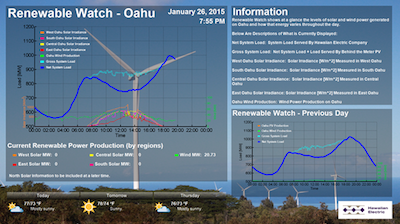Hawaii has been getting a lot of attention recently for its efforts to reduce its use of fossil fuel-based energy. The state has the highest electricity costs in the U.S. Most recently, NextEra Energy announced its intent to acquire Hawaiian Electric Industries who owns three electric utilities that supply power to 95 percent of the state’s population. NextEra Energy Resources is one of the largest developers of renewable energy in the U.S. and intends on continuing the trend of adding solar power to its portfolio.
According to a recent “Today in Energy” published by the Energy Information Administration (EIA), high electricity prices in Hawaii have made wind and solar technologies economically attractive alternatives – even more so as prices have come down in recent years. This has led to a growing use of wind and solar energy at both utiity scale and in distributed applications such as rooftop solar PV.
EIA’s monthly net metering utility data finds 9,200 net-metered PV systems were added in 2014 through October, bringing the total number of customers with net-metered PV to around 48,000. In Oahu, where most of the state’s population resides, the Solar Electric Power Association finds that roughly 12 percent of customers have rooftop solar compared to only .5 percent average throughout the rest of the U.S. The average capacity of residential net-metered PV systems in Hawaii has also been increasing as larger and more efficient PV systems are installed.
However, the state has seen delays in adding additional solar to the power grid. EIA attributes the delays to circuits on the Hawaiian Electric distribution grids reaching levels of rooftop PV capacity that are 120 percent or more of the circuit’s daytime minimum load—a key threshold for Hawaiian Electric’s interconnection approval process. Once that threshold is passed, an interconnection study may be required before the new PV system can be approved, which has resulted in a backlog of PV applications.
EIA notes that Hawaiian Electric recently entered a cooperative research partnership with the National Renewable Energy Laboratory, the Electric Power Research Institute, and SolarCity to study the operational effects of high levels of solar PV on electric grids.Preliminary research results have lead Hawaiian Electric to announce plans to clear its backlog of PV applications by April 2015.
As a result of the research, Hawaiian Electric has proposed in a filing to the Hawaii Public Utilities Commission (PUC) to raise the allowable PV penetration threshold from 120 percent to 250 percent of a circuit’s daytime minimum load. However, this change would be accompanied by a decrease in the amount received by new net-metered PV customers for the excess electricity they send back to the grid. EIA explains Instead of receiving the full retail rate (about $.30/kilowatthour (kWh) for Oahu residential customers in January 2015), customers would receive something closer to Hawaiian Electric’s cost of avoided generation, which largely reflects the cost of purchased fuel. Hawaiian Electric states that the new rate would distribute grid operation costs equitably across solar and nonsolar customers and allow the distributed solar program to be sustainable.
Many utilities around the country are similarly engaged in efforts to establish appropriate compensation rates for distributed solar customers while ensuring equitable costs to all customers.


